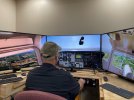Tom-Flying
Pre-Flight
- Joined
- Apr 5, 2009
- Messages
- 44
- Display Name
Display name:
Tom
Hi,
Is anyone aware of a good G5 simulator to help familiarize a pilot transitioning from a six pack to all digital?
Any suggestions would be appreciated!!
Thanks,
Tom
Is anyone aware of a good G5 simulator to help familiarize a pilot transitioning from a six pack to all digital?
Any suggestions would be appreciated!!
Thanks,
Tom


